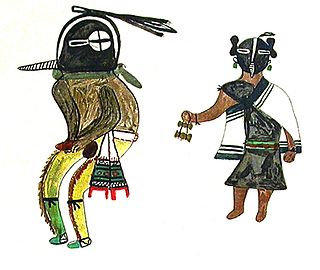
Kokopelli is a fertility deity, usually depicted as a humpbacked flute player, who is venerated by some Native American cultures in the Southwestern United States. Like most fertility deities, Kokopelli presides over both childbirth and agriculture. He is also a trickster god and master braider and represents the spirit of music.

A kachina is a spirit being in the religious beliefs of the Pueblo peoples, Native American cultures located in the south-western part of the United States. In the Pueblo cultures, kachina rites are practiced by the Hopi, Zuni, Hopi-Tewa, and certain Keresan tribes, as well as in most Pueblo tribes in New Mexico.
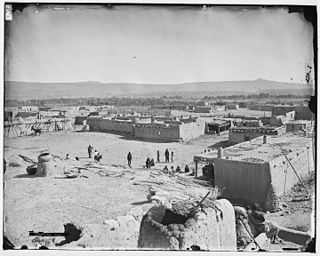
Cochiti is a census-designated place (CDP) in Sandoval County, New Mexico, United States. A historic pueblo of the Cochiti people, it is part of the Albuquerque Metropolitan Statistical Area. The population was 528 at the 2010 census. Located 22 miles (35 km) southwest of Santa Fe, the community is listed as a historic district on the National Register of Historic Places.

Kewa Pueblo is a federally-recognized tribe of Native American Pueblo people in northern New Mexico, in Sandoval County southwest of Santa Fe. The pueblo is recorded as the Santo Domingo Pueblo census-designated place by the U.S. Census Bureau, with a population of 2,456 at the 2010 census.

The Zuni are Native American Pueblo peoples native to the Zuni River valley. The Zuni are a Federally recognized tribe and most live in the Pueblo of Zuni on the Zuni River, a tributary of the Little Colorado River, in western New Mexico, United States. The Pueblo of Zuni is 55 km (34 mi) south of Gallup, New Mexico. The Zuni tribe lived in multi level adobe houses. In addition to the reservation, the tribe owns trust lands in Catron County, New Mexico, and Apache County, Arizona. The Zuni call their homeland Halona Idiwan’a or Middle Place. The word Zuni is believed to derive from the Western Keres language (Acoma) word sɨ̂‧ni, or a cognate thereof.
New Mexico is a state of the Southwest United States. The state has music traditions dating back to the ancient Anasazi and Pueblo people, Navajo, Apache, and the Spanish Santa Fe de Nuevo México; these old traditions are found in both their original folk forms and as a modern folk genre known as New Mexico music.

Mogollon culture is an archaeological culture of Native American peoples from Southern New Mexico and Arizona, Northern Sonora and Chihuahua, and Western Texas. The northern part of this region is Oasisamerica, while the southern span of the Mogollon culture is known as Aridoamerica.

Hovenweep National Monument is located on land in southwestern Colorado and southeastern Utah, between Cortez, Colorado and Blanding, Utah on the Cajon Mesa of the Great Sage Plain. Shallow tributaries run through the wide and deep canyons into the San Juan River.
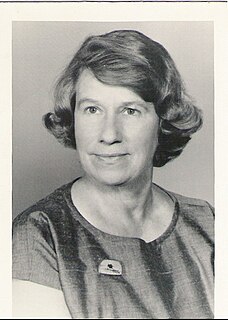
Dorothy Dunn Kramer was an American art instructor who created The Studio School at the Santa Fe Indian School.

Matilda Coxe Stevenson, who also wrote under the name Tilly E. Stevenson, was an American ethnologist, geologist, explorer, and activist. She was a supporter of women in science, helping to establish the Women's Anthropological Society in Washington DC. Stevenson was also the first woman hired by the Bureau of American Ethnology (BAE) to research southwestern Indigenous people. In doing so, she published multiple monographs and one long text on the Zuni people. Her work was supported by some of her male colleagues at the time and was seen as a contemporary by some of her fellow ethnologists or anthropologists. However, she faced barriers as a woman scientist in the nineteenth and early twentieth centuries; in order to compete, she defied societal expectation which pushed some to regard her as stubborn and aggressive.
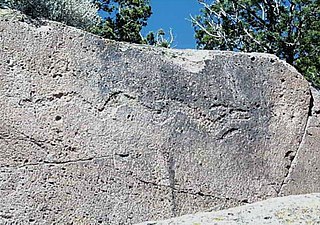
Avanyu, is a Tewa deity, the guardian of water. Represented as a horned or plumed serpent with curves suggestive of flowing water or the zig-zag of lightning, Awanyu appears on the walls of caves located high above canyon rivers in New Mexico and Arizona. Avanyu may be related to the feathered serpent of Mesoamerica–Quetzalcoatl and related deities. Avanyu is a frequent motif on Native American pottery of the Southwestern United States.

Pottery Mound was a late prehistoric village on the bank of the Rio Puerco, west of Los Lunas, New Mexico. It was an adobe pueblo most likely occupied between 1350 and 1500. The site is best known for its 17 kivas, which yielded a large number of murals. A 2007 book, New Perspectives on Pottery Mound Pueblo provides a general introduction to the site.
The Taos Society of Artists was an organization of visual arts founded in Taos, New Mexico. Established in 1915, it was disbanded in 1927. The Society was essentially a commercial cooperative, as opposed to a stylistic collective, and its foundation contributed to the development of the tiny Taos art colony into an international art center.

Anton Docher (1852–1928), born Antonin Jean Baptiste Docher, was a French Franciscan Roman Catholic priest, who served as a missionary to Native Americans in New Mexico, in the Southwest of the United States. He served 34 years with the Pueblo of Isleta and was known for defending the Indians.

The Pueblo II Period was the second pueblo period of the Ancestral Puebloans of the Four Corners region of the American southwest. During this period people lived in dwellings made of stone and mortar, enjoyed communal activities in kivas, built towers and dams for water conservation, and implemented milling bins for processing maize. Communities with low-yield farms traded pottery with other settlements for maize.

Art of the American Southwest is the visual arts of the Southwestern United States. This region encompasses Arizona, New Mexico, and parts of California, Colorado, Nevada, Texas, and Utah. These arts include architecture, ceramics, drawing, filmmaking, painting, photography, sculpture, printmaking, and other media, ranging from the ancient past to the contemporary arts of the present day.

New Mexico music is a genre of music that originated in the US state of New Mexico, it derives from the Pueblo music in the 13th century, and with the folk music of Hispanos during the 16th to 19th centuries in Santa Fe de Nuevo México. The style went through several changes during pre-statehood, mostly during the developments of Mexican folk and cowboy Western music.

Pueblo pottery are ceramic objects made by the indigenous Pueblo people and their antecedents, the Ancestral Puebloans and Mogollon cultures in the Southwestern United States and Northern Mexico. For centuries, pottery has been central to pueblo life as a feature of ceremonial and utilitarian usage. The clay is locally sourced, most frequently handmade, and fired traditionally in an earthen pit. These items take the form of storage jars, canteens, serving bowls, seed jars, and ladles, serving the needs of daily life. Some utility wares were undecorated except from simple corrugations or marks made with a stick or fingernail, however many examples for centuries were painted with abstract or representational motifs. Some pueblos made effigy vessels, fetishes or figurines such as Cochiti Pueblo. During modern times, pueblo pottery was produced specifically as an art form to serve an economic function. This role is not dissimilar to prehistoric times when pottery was traded throughout the Southwest, and in historic times after contact with the Spanish colonialists.
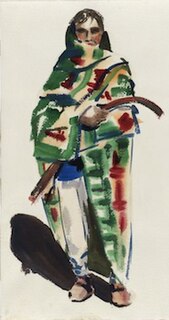
José Vicente Aguilar, also called Sua Peen, is a Pueblo-American painter of San Ildefonso Pueblo and Picurís Pueblo heritage. He is known for his watercolor paintings. Aguilar has exhibited across the United States, particularly in the Southwest, and his work is in the permanent collection of institutions including the Gilcrease Museum.


















